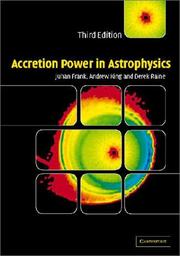| Listing 1 - 4 of 4 |
Sort by
|
Book
ISBN: 1683926803 9781683926801 1683926811 9781683926818 168392682X 9781683926825 Year: 2021 Publisher: Dulles, Virginia : Mercury Learning & Information,
Abstract | Keywords | Export | Availability | Bookmark
 Loading...
Loading...Choose an application
- Reference Manager
- EndNote
- RefWorks (Direct export to RefWorks)
Newtonian mechanics is taught as part of every physics program for several reasons. It is a towering intellectual achievement; it has diverse applications; and it provides a context for teaching modelling and problem solving. This text gives equal prominence to all three missions. It therefore includes some advanced material as well as the customary introductory topics and is designed to be studied over an extended time-frame. The problem-solving aspects are developed more fully than in many other texts; showing readers how problems are approached and bringing out the ways of going about constructing a model and solution.FEATURES:Includes some advanced material as well as the customary introductory topicsThe problem-solving aspects are developed more fully than in many other texts; showing readers how problems are approached and bringing out the methods of going about constructing a model and solution.
Book
ISBN: 1683922069 9781683922063 9781683923305 1683923308 9781683922056 1683922050 Year: 2019 Publisher: Dulles Mercury Learning and Information
Abstract | Keywords | Export | Availability | Bookmark
 Loading...
Loading...Choose an application
- Reference Manager
- EndNote
- RefWorks (Direct export to RefWorks)
This introduction to the mathematical concepts used to describe fundamental physics principles is peppered with numerous examples and applications which enable the reader to master the complex mathematical concepts needed to define topics such as relativity, mechanics, and electromagnetics. Applications are included in every chapter.
Mathematical physics. --- Physical sciences --- Mathematics.
Book
ISBN: 364254942X 3642549438 Year: 2014 Publisher: Berlin, Heidelberg : Springer Berlin Heidelberg : Imprint: Springer,
Abstract | Keywords | Export | Availability | Bookmark
 Loading...
Loading...Choose an application
- Reference Manager
- EndNote
- RefWorks (Direct export to RefWorks)
This book constitutes the refereed proceedings of the 7th International Conference on Quantum Interaction, QI 2013, held in Leicester, UK, in July 2013. The 31 papers presented in this book were carefully selected from numerous submissions. The papers cover various topics on quantum interaction and revolve around four themes: information processing/retrieval/semantic representation and logic; cognition and decision making; finance/economics and social structures; and biological systems.
Artificial intelligence --- Computer science. --- Artificial intelligence. --- Information storage and retrieva. --- Computation by Abstract Devices. --- Artificial Intelligence. --- Information Storage and Retrieval. --- Quantum Computing. --- AI (Artificial intelligence) --- Artificial thinking --- Electronic brains --- Intellectronics --- Intelligence, Artificial --- Intelligent machines --- Machine intelligence --- Thinking, Artificial --- Bionics --- Cognitive science --- Digital computer simulation --- Electronic data processing --- Logic machines --- Machine theory --- Self-organizing systems --- Simulation methods --- Fifth generation computers --- Neural computers --- Informatics --- Science --- Information storage and retrieval systems. --- Automatic data storage --- Automatic information retrieval --- Automation in documentation --- Computer-based information systems --- Data processing systems --- Data storage and retrieval systems --- Discovery systems, Information --- Information discovery systems --- Information processing systems --- Information retrieval systems --- Machine data storage and retrieval --- Mechanized information storage and retrieval systems --- Computer systems --- Electronic information resources --- Data libraries --- Digital libraries --- Information organization --- Information retrieval --- Computers. --- Information storage and retrieval. --- Quantum computers. --- Computers --- Automatic computers --- Automatic data processors --- Computer hardware --- Computing machines (Computers) --- Electronic calculating-machines --- Electronic computers --- Hardware, Computer --- Cybernetics --- Calculators --- Cyberspace --- Theory of Computation. --- Data centers

ISBN: 1107127750 1280417358 9786610417353 1139164244 0511077548 0511180195 0511204302 0511307179 0511075979 9780511077548 0521620538 9780521620536 0521629578 9780521629577 9781139164245 Year: 2002 Publisher: Cambridge, U.K. ; New York : Cambridge University Press,
Abstract | Keywords | Export | Availability | Bookmark
 Loading...
Loading...Choose an application
- Reference Manager
- EndNote
- RefWorks (Direct export to RefWorks)
Accretion Power in Astrophysics examines accretion as a source of energy in both binary star systems containing compact objects, and in active galactic nuclei. Assuming a basic knowledge of physics, the authors describe the physical processes at work in accretion discs and other accretion flows. The first three chapters explain why accretion is a source of energy, and then present the gas dynamics and plasma concepts necessary for astrophysical applications. The next three chapters then develop accretion in stellar systems, including accretion onto compact objects. Further chapters give extensive treatment of accretion in active galactic nuclei, and describe thick accretion discs. A new chapter discusses recently discovered accretion flow solutions. The third edition is greatly expanded and thoroughly updated. New material includes a detailed treatment of disc instabilities, irradiated discs, disc warping, and general accretion flows. The treatment is suitable for advanced undergraduates, graduate students and researchers.
| Listing 1 - 4 of 4 |
Sort by
|

 Search
Search Feedback
Feedback About UniCat
About UniCat  Help
Help News
News